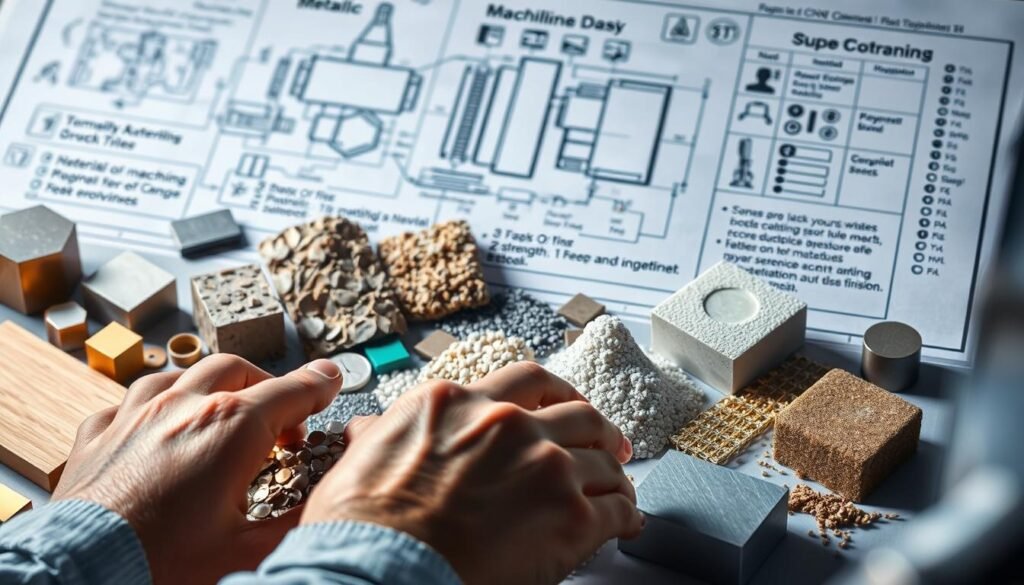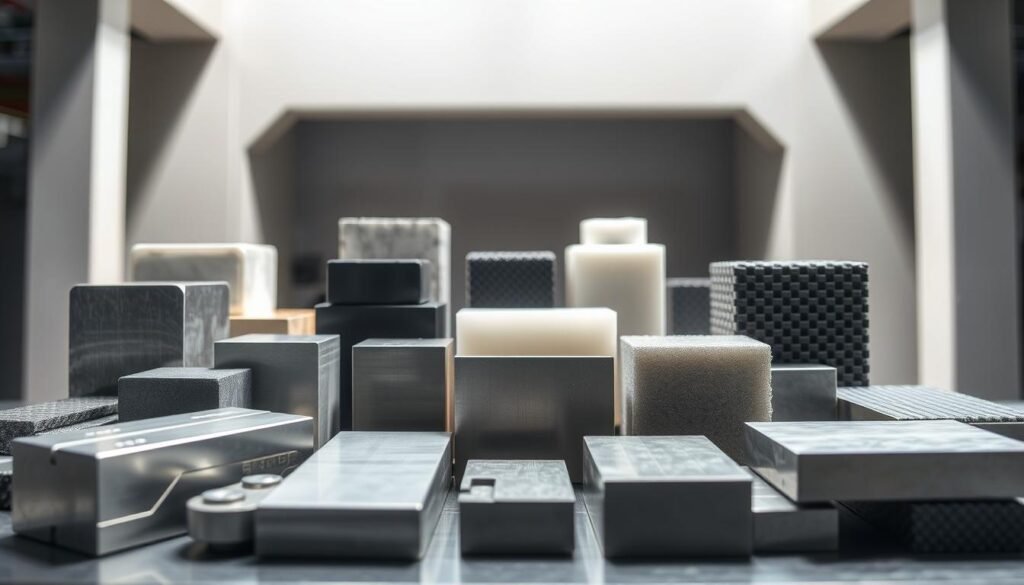Have you ever wondered why some CNC machined parts work perfectly and others don’t? Picking the right material for CNC machining matters a lot for top performance. In this guide, we’ll look at the many precision engineering materials, helping you choose wisely for your projects.
Key Takeaways
- It’s important to know the wide variety of CNC machining materials for the best selection.
- The material chosen greatly affects how well CNC machined parts work and last.
- Both beginners and pros can learn a lot from a detailed guide on CNC machine materials.
- It’s key to weigh things like stress, load, and cost when choosing materials for CNC machining.
- Understanding what popular CNC machining materials are used for helps in making smart choices.
Introduction to CNC Machining Materials
Today’s industries move fast, making it vital to know about CNC materials. The rise of CNC machining has given us many material choices. These materials are used in automotive, aerospace, and medical fields, helping to create detailed designs with high precision. They also make sure the end product is strong and works well.
Choosing the right CNC material means understanding what each one can do. We often use metals like steel, brass, and aluminum, and plastics such as PP, POM, and PC. Picking the right material affects your CNC project’s success greatly.
To choose well, think about several important factors:
- Resistance to moisture and corrosion
- Ability to withstand extreme temperatures
- Stress and load capacity
- Dimensional tolerance
- Durability
For an in-depth look at CNC materials, check out this detailed guide.
When you learn about CNC materials, you also learn why their features are key. Considerations like operating temperature, sustainability, and environmental impact matter a lot. This is especially true if the product will be used in different settings.
It’s also crucial to follow material grades and industry standards (like ISO, ASTM, ASME, SAE). This ensures the quality and compatibility for specific uses. This matters most in fields where accuracy and reliability are critical.
Here’s a quick overview of some major CNC materials and what they offer:
| Material | Key Characteristics | Applications |
|---|---|---|
| Steel | High strength, corrosion resistance | Automotive, industrial machinery |
| Aluminum | Lightweight, excellent machinability | Aerospace, consumer electronics |
| Polycarbonate (PC) | Impact resistance, clarity | Medical devices, safety equipment |
| Polypropylene (PP) | Chemical resistance, flexibility | Piping systems, automotive components |
Knowing about CNC material options helps you make wise choices in your projects. You can select the best materials for your specific needs, ensuring success.
Essential Questions for Selecting the Right CNC Material
Understanding your application is key to picking the right CNC material. Start by figuring out the purpose and function of the CNC part. Ask if the part needs to handle mechanical stress or if looks are more important. Looking at these material selection questions helps you pick materials that match your project’s needs.
Think about the environment too. You must consider if there will be exposure to chemicals, changes in temperature, and moisture. These factors can affect how well certain CNC materials work. For example, ABS and Nylon react differently in tough environments.
It’s also important to look at stress and load demands. Know how much mechanical pressure the materials must handle. This could be about resisting impacts or supporting weight. This step makes sure you focus on materials that can endure specific conditions.

In summary, picking the right CNC material involves understanding your project deeply. This includes thinking about the environment and what the material needs to withstand. By doing all this, you make sure the material you choose fits its intended purpose perfectly.
Properties of Materials in CNC Machining
When picking materials for CNC machining, it’s key to look at several features to make sure they perform well. One important area to understand is the thermal properties of the materials. These show how materials act when temperatures change. They also tell if materials can handle high heat without changing shape or breaking down. Materials good at resisting heat are preferred for jobs where too much heat could ruin the quality of the part.
Also, the mechanical properties CNC machining needs include the material’s strength, how bendy it is, and how long it lasts. These points are crucial because they help figure out if the material can stand up to the job’s demands. For example, materials that are very strong are best for jobs where there’s a lot of pressure or weight.
Another key feature is corrosion resistance. In places where rust can be a problem, it’s important to choose materials wisely. This matters a lot in certain fields like the marine industry, chemical processing, and any outdoor use.
Looking at these properties of materials helps us choose wisely for material properties CNC machining. This leads to making parts that are of better quality, last longer, and are more dependable.
| Material | Thermal Properties | Mechanical Properties | Corrosion Resistance |
|---|---|---|---|
| Aluminum | High | Moderate | Moderate |
| Stainless Steel | Moderate | High | High |
| Titanium | High | High | High |
Popular CNC Machining Materials and Their Applications
Choosing the right materials is key for the best CNC machining results. There are many metals and plastics used. Each type is suited for different needs.
Metals are common in CNC because they are strong and flexible. Aluminum is liked for being light, tough, and easy to shape, making it perfect for planes and cars. Steel is famous for its toughness and is used in machines and car parts. Brass looks good and handles heat well, so it’s used in things like pipes and musical gear.
Plastics are getting more popular in CNC for being light and cheap. ABS is tough and used for things like cases and panels. Nylon is strong and wears down slowly, making it great for gears and parts that move. Polycarbonate is tough and clear, so it’s used in safety gear and windows.
There are also specialty CNC materials for special jobs. Phenolics are strong and resist heat, used in electric parts and boards. Rigid foam is light and keeps heat in or out, so it’s used in building and making models.

To better understand popular CNC materials and their uses, let’s check the table below:
| Material | Properties | Typical Applications |
|---|---|---|
| Aluminum | High strength-to-weight ratio, corrosion resistance | Aerospace, automotive |
| Steel | Strength, durability | Industrial machinery, automotive components |
| Brass | Thermal conductivity, aesthetic appeal | Plumbing fixtures, musical instruments |
| ABS | Impact resistance, strength | Enclosures, panels |
| Nylon | Toughness, wear resistance | Gears, bearings, bushings |
| Polycarbonate | Impact resistance, optical clarity | Safety equipment, glazing |
| Phenolics | Mechanical strength, heat resistance | Electrical insulators, circuit boards |
| Rigid Foam | Lightweight, thermal insulation | Construction, modeling |
Stress and Load Considerations in Material Selection
When picking materials for CNC machining, think about stress and load. The chosen material must have a great load capacity. This means it can handle tough conditions well. Materials face different stresses, like pulling, pushing, or cutting forces.
The ability of a material to take on various stresses is called its stress considerations. This includes both short-term and long-term impacts. For instance, materials in cars must endure constant heavy use. So, it’s vital to know a material’s stress handling to ensure it lasts long.
Each material handles stress in its own way. Metals, such as steel and aluminum, are strong and used where strength is needed. Plastics are more about being light but can still be tough enough for easier jobs. Here’s how different materials stack up in terms of handling stress, during machining, and overall toughness:
| Material | Stress Considerations | Load Capacity | Durability |
|---|---|---|---|
| Steel | High tensile strength, good for heavy loads | Excellent | High |
| Aluminum | Strong yet lightweight, moderate corrosion resistance | Very Good | Moderate to High |
| Plastics | Lightweight, suitable for lower stress applications | Moderate | Varies by type |
| Titanium | High strength-to-weight ratio, excellent corrosion resistance | Excellent | High |
Cost Analysis: Balancing Budget and Performance
Understanding the balance between budget and performance in CNC machining is key. High-strength materials like titanium and carbon fiber composites come with a higher price. But, they are great for high-performance needs because of their toughness.
Those seeking more budget-friendly options might consider aluminum and plastics. These materials are good for many projects and help manage expenses. They offer a good mix of performance and affordability.
Selecting materials wisely lets us get the most out of both performance and budget. Below, you’ll find a table comparing the cost and performance of different CNC materials:
| Material | Strength (MPa) | Cost per Pound ($) | Performance/Cost Ratio |
|---|---|---|---|
| Titanium | 950 | 30 | High |
| Carbon Fiber | 1500 | 35 | Very High |
| Aluminum | 310 | 2 | Moderate |
| ABS Plastic | 45 | 1 | Low |
The table shows that high-performance CNC materials like titanium and carbon fiber are top-notch. Aluminum and ABS plastic offer good value too, especially when costs matter in CNC machining. The trick is to spot the best material that balances both cost and performance for your project.
CNC Machining Materials Guide
This comprehensive CNC machining materials guide aims to be a quick, full reference. It covers the various materials used in CNC machining. We’ll look at their unique traits, uses, and how much they might cost you.
Choosing the right material for a CNC project can be puzzling. Complete CNC materials guides suggest looking at strength, how long it lasts, how easy it is to shape, and how it reacts to the environment. Each material, like metals, plastics, or composites, has special qualities for different jobs.
We’ve covered popular CNC materials such as aluminum, stainless steel, brass, and plastics like polycarbonate and ABS. Each has key features and typical applications. For example, aluminum is light and fights corrosion well, whereas ABS is tough against impacts and is easy to work with.
Think about what stresses the final product will face. Heavy uses may need steel or titanium. Lighter uses could work well with some plastics or softer metals. Our CNC materials reference offers all you need to make these choices easily.
Cost plays a big role in picking materials. It’s tough to match what you need with what you can spend. Titanium is strong and lasts long but costs a lot. On the flip side, some plastics are cheaper and might fit less tough jobs.
Here’s a quick look at some common CNC machining materials:
| Material | Key Properties | Applications | Cost Considerations |
|---|---|---|---|
| Aluminum | Lightweight, Corrosion-Resistant | Automotive, Aerospace, Consumer Electronics | Moderate |
| Stainless Steel | High Strength, Corrosion-Resistant | Medical Devices, Kitchenware, Industrial Equipment | High |
| ABS Plastic | Impact-Resistant, Easy to Machine | Prototypes, Consumer Goods, Automotive Interiors | Low |
With this complete guide, manufacturers and engineers can choose wisely. This ensures their CNC projects are strong, last long, and stay within budget.
Conclusion
In wrapping up our CNC Machining Materials Guide, it’s clear that picking the right material is key. Knowing about different materials helps us make smart choices. This knowledge is vital for anyone wanting to improve their machining work.
Thinking about factors like stress, how heavy the load is, and costs shows us how important it is to choose wisely. Finding a balance between cost and quality is crucial. Understanding our options in CNC materials shows their big effect on our projects.
We suggest taking a close look at your project needs. Talking to experts and using specialized services can help a lot. In closing, picking materials wisely is a must for good results in CNC machining.
FAQ
What is the importance of material selection in CNC machining?
Choosing the right material for CNC machining is crucial. It affects how well the final product works, lasts, and performs. The material must fit the part’s specific needs, like its strength and look.
How do I define the purpose and functionality of a CNC machined part?
Think about what stresses the part will face, how it needs to look, and its function. This helps pick materials that can handle these needs well.
What environmental factors should I consider when selecting materials for CNC machining?
Consider if the material will face chemicals, changes in temperature, or moisture. These factors can affect how long and how well the material lasts.
How do I assess the stress and load requirements for CNC materials?
Look at the mechanical loads and stresses the material will need to withstand. Think about its ability to resist impacts and bear loads for its application.
Why are thermal properties important in material selection for CNC machining?
Thermal properties matter because they show how a material acts with temperature changes. The material should keep its shape and strength at high temperatures, especially when heat is a big factor.
What mechanical properties should I look for in CNC machining materials?
Look for strength, flexibility, and durability. These make sure the material can handle its intended use, supporting and lasting as needed.
Why is corrosion resistance critical in selecting CNC machining materials?
Materials that resist corrosion last longer, especially in places with chemicals or moisture. This makes parts more reliable and durable.
What are some common metals used in CNC machining?
Aluminum, steel, and brass are often used. They’re liked for their good properties, affordability, and how well they work for many uses, like in cars and electronics.
What are the benefits of using plastics in CNC machining?
Plastics are light, don’t cost much, and are easy to shape. They’re great for when you want to make things lighter and easier to make.
What are some specialty materials used in CNC machining and their applications?
Specialty materials like phenolics and rigid foam have special features. They’re great for things like electrical insulation and strong structures, useful in specific needs.
How do high-strength materials compare to economical options in CNC machining?
Strong materials cost more but are better for tough jobs. Cheaper options are good for many needs, offering a good mix of cost and use.
What strategies can be used to find cost-effective solutions in material selection?
Finding cost-effective materials means mixing the right properties with your budget. Sometimes, cheaper materials work well enough, or spending more on advanced materials pays off.




